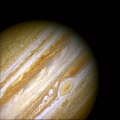Súbor:An Ancient Storm in the Jovian Atmosphere - GPN-2000-000910.jpg

Veľkosť tohto náhľadu: 601 × 599 pixelov. Iné rozlíšenia: 241 × 240 pixelov | 481 × 480 pixelov | 770 × 768 pixelov | 1 027 × 1 024 pixelov | 1 496 × 1 492 pixelov .
Pôvodný súbor (1 496 × 1 492 pixelov, veľkosť súboru: 701 KB, MIME typ: image/jpeg)
História súboru
Po kliknutí na dátum/čas uvidíte ako súbor vyzeral vtedy.
| Dátum/Čas | Náhľad | Rozmery | Používateľ | Komentár | |
|---|---|---|---|---|---|
| aktuálna | 21:20, 17. január 2016 |  | 1 496 × 1 492 (701 KB) | Ras67 | higher resolution |
| 00:50, 9. apríl 2009 |  | 718 × 716 (261 KB) | BotMultichillT | {{Information |Description={{en|1=When 17th-century astronomers first turned their telescopes to Jupiter, they noted a conspicuous reddish spot on the giant planet. This Great Red Spot is still present in Jupiter's atmosphere, more than 300 years later. I |
Použitie súboru
Na tento súbor odkazujú nasledujúce 2 stránky:
Globálne využitie súborov
Nasledovné ďalšie wiki používajú tento súbor:
- Použitie na ar.wikipedia.org
- Použitie na ru.wikipedia.org


